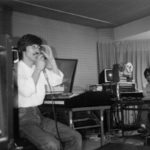
Guest post by Giacomo Lee.
The first thing that strikes you about Asian Wind is its sleeve. The striking pink and upside-down triangle on the front cover is the handiwork of design group Sign, a Japanese trio who were responsible for, among other things, the cover of Sakamoto’s Thousand Knives LP )back in the tail end of the 1970s). Compared to the rest of the studio’s output, only two other records comes close to Asian Wind in terms of colour and brashness, and those are also both by the same synth legend: Yoshitaka Azuma.
Including Asian Wind, we could call the first three LPs by the musician his “Asian Trilogy”; all three were released at the start of the 1980s, with this LP coming out in Japan just a few months after the release of debut Moonlight in Asia. That album catches the eye as much as its follow-up, its cover a take on the Japanese flag where the Rising Sun is an entrancingly bright orange circle — instead of a rounded jot of blood.

The trilogy is an ode to Asia, then, but perhaps Asia as seen from space. Azuma’s albums as a whole always have a ‘cosmic’ edge, and Asian Wind is no exception. While the Trilogy may be an outlier visually in the oeuvre of Sign, Azuma’s sophomore effort sits comfortably alongside its predecessor and follow-up Far from Asia. But just how like the second movie in a cinematic series is usually regarded to the best, the same thinking can be applied to this four track collection from the summer of 1981 that glistens with the same lucid intensity of its visuals.
Prior to that year, Yoshitaka Azuma had been essentially missing in action as a performer for a whole decade, being last seen as the piano and organ man for folk group Itsutsu No Akai Fusen. Circa 1976, Azuma went ‘electric’ and opened up his own synth-decked studio in Osaka. This laid-back Japanese coastal city is important in Japanese electronic music history for having hosted the Universal Exhibition of 1970, one of the first Expos in Japan to promote electronic music as the sound of things to come.
Azuma was from neighbouring Nara, so it was probably convenience that led him to set up his Ton Studio in Osaka, but no doubt the Expo’s impact made his leap from folk into synthesizer music a natural progression. That said, Azuma’s humble apartment room studio didn’t become a home to those wishing to record an album in the style of, say, Isao Tomita. Though in a later form it became used for recordings by the likes of Psy . S, Ton Studio’s first incarnation was as a factory of sound effects (for both screen and stage). The studio actually became a victim of its own success, with Azuma spending all hours putting together sounds for the likes of local stations such as ABC (Asahi Broadcasting Corporation).

Somehow, Azuma managed to find time amidst all this to put together his first two albums, records that don’t sound like they were borne from professional chaos but instead reflect a certain meticulousness and tranquility. Put that down perhaps to the laid-back vibes of Osaka itself, which makes even the relatively rough and ready city’s most grittiest of areas, seem like great places to lounge around for a while, taking in some Asian breeze.
Again, Azuma’s work often has this wistful air, although this arguably changed a little by the end of the ’80s once he became known simply by his last name, as part of the American label Private Music. Where during this period his synthesizers went more polished and overt as opposed to ambient, Asian Wind and its brethren are of a more trance-inducing bent, lulling you into Azuma’s spacey interpretation of the “East”. There are few of Azuma’s latter dark, downtempo chords or more blatant New Age melodies jolting the listener back into reality or dating the record to a specific era. Instead, Asian Wind somehow balances Kosmiche with a pulse that wouldn’t be out of place in today’s synthwave saturated music-scape.
Anyone listening to second track Akinogahara would be forgiven for thinking they’d stumbled across another Stranger Things theme/Survive copycat, in the way it creeps up on you with a very modern-sounding aesthetic. The only ‘tell’ to its age is a 15 minute run-time that wouldn’t have raised an eyebrow in the Kosmiche era, and which probably caught the attention of Peter Baumann, the Tangerine Dream member who went on to found Private Music.
Azuma though adds its own twist to the German genre, with most of Asian Wind’s tracks fading out before adding an outro that could be a track of its own; the piece that sees out the wistful title track is a very different and dramatic-sounding coda, for example. Repeating rhythms never stay the same, evolving naturally with the intensity of the dancefloor. It’s like slowed down cosmic disco meets Kosmiche; Kosmiche Disco, if you will.
The last quarter of closer “Memories to the Orient” is an altogether different beast to the space-trip that precedes it, plodding along at a funereal pace to the tune of processed synths and the very Earthy sounding click of a drum stick. For a minute it teases turning into a lounge piece before a heartbeat enters the audio and that drum stick slows down even more, as if its player is on the verge of death, their last heartbeats being the sound we’re hearing.

It’s a stark, monochrome ending to a 50 minute ride that otherwise feels as colourful and otherworldly as that translucent cover art. In other words, like all good midway points, it’s an aptly dour way to end the second act of a trilogy.
